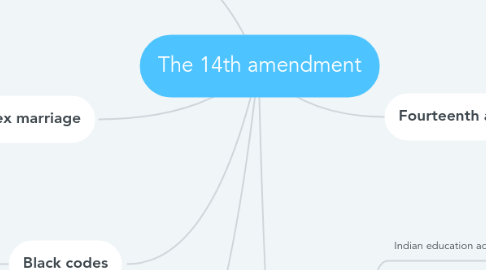
1. Black codes
1.1. This limited the rights of newly freed African American and to continue the white dominance that had existed under slavery.
2. Dred Scott
2.1. was an enslaved African American who lived with his owner in the slave state of Missouri
2.2. After his owner died he sued for his freedom
2.3. But he was not a citizen so he had no legal right to sue
3. Same-sex marriage
3.1. some states allowed same-sex marriages, while others made them illegal.
4. Court cases
4.1. Brown v. Board of education
4.1.1. was a landmark case in the struggle for African American equality in the United States
4.2. Plessy v. Ferguson
4.2.1. was a case in 1896 in which the Supreme Court ruled that racial segregation in public places was legal
5. Fourteenth amendment
5.1. says that no state can create or enforce a law that denies “any person within its jurisdiction the equal protection of the laws.”
6. Acts
6.1. Indian education act (1972)
6.1.1. Was to improve native Americans education
6.2. Civil rights acts
6.2.1. This put an end to all forms of discrimination and legal segregation in public places
6.2.2. This law outlawed the denial of voting rights based on race
6.3. Americans with disabilities act (1990)
6.3.1. This law extends equal protection to people with physical or mental disabilities
6.3.2. This act allows Americans with disabilities to work to have the same opportunities in the economy and government programs
6.4. Voting rights act of 1965
6.4.1. required federal approval of all election changes in states with a history of denying voter eligibility
6.5. Equal pay
6.5.1. "No employer . . . shall discriminate . . . between employees on the basis of sex by paying wages to employees in such establishment at a rate less than the rate at which he pays employees of the opposite sex in such establishment for equal work. . .”
6.6. Equal protection
6.6.1. prevents workplace discrimination

